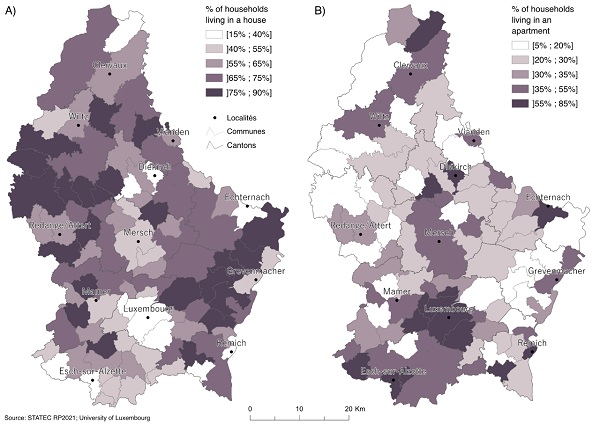 Share of private households living in a house (A) and a flat (B) by municipality;
Credit: STATEC
Share of private households living in a house (A) and a flat (B) by municipality;
Credit: STATEC
Luxembourg's statistical institute, STATEC, recently published a report providing an overview of residents' housing, using data taken from the 2021 population census.
In 2021, Luxembourg's housing stock consisted mainly of apartments (52.8%) and houses (45.9%), while other types of housing (mainly farms) made up just 1.2% of private households' housing stock.
Yet, more than half of all residents lived in houses, which are generally larger and accommodate more people than apartments.
STATEC added that the distribution of the two main housing types by municipality remained heterogeneous in 2021. The most populous municipalities were characterised by a high proportion of apartments (over 55% of all dwellings). By contrast, the least populated municipalities had a 75% proportion of houses.
The housing stock was found to be well diversified in terms of era of construction: 17.3% of dwellings had been built since the population census in 2011, compared with 18.9% before 1945. The recent trend has been to build more apartments than houses. As a result, the housing stock made up of houses is older than the more recent housing stock made up of apartments.
The 2021 census also asked homeowners about renovation work carried out in their dwellings. 29.2% said they had carried out energy-related work, 21.2% had changed windows, 14.1% had carried out roofing work, 9.0% wall work, 3.2% cellar work and 2.0% floor work (multiple answers possible).
On average, house owners were six times more likely than flat owners to declare that they had carried out various types of renovation work.
Moreover, the 2021 census revealed that 54.4% of homes in Luxembourg had a floor area of more than 120m2. The distribution of dwellings by surface area had changed slightly since the 2011 census. Large dwellings (over 150m2) still accounted for over a third of all dwellings in Luxembourg, while the proportion of small dwellings (under 30m2) remained very low (1.3%).
Medium-sized flats (60m2-100m2) made up 51.2% of all flats.
Households living in the least populated municipalities - where there are more houses - often had more than 80m2 per occupant. On the other hand, in Luxembourg City and the municipalities in the south where there is a high proportion of flats, many households had less than 30m2 per person.
STATEC also noted that migration status is a dividing line in terms of living space. There was a significant difference between households with a reference person of Luxembourgish nationality (the majority of which had more than 40m2 per occupant) and other households (the majority of which had 20m2-60m2 per occupant).
However, the parents' place of birth also plays a role: 63% of households with a parent born in Luxembourg had more than 60m2 per occupant. By contrast, only 42% of households with two parents born abroad had the same floor space.
Households with a non-EU reference person were more likely to live in accommodation with less than 30m2 per occupant.
The census also found that nearly two-thirds of tenants had been living in their home for less than five years. In less densely populated areas, most households had been living in their home for more than 20 years.
Among the responses obtained, the 2021 census showed that 91.6% of tenants paid standard rent and 8.4% paid reduced-rate rent. On average, the rent for houses was €11/m2, while it was €18/m2 for flats.
In terms of total money supply, the 44,076 households paying rent in 2021 transferred almost €60 million per month to their landlords, which is equivalent to almost €720 million per year. Of the €60 million paid in rent each month in Luxembourg, €22.5 million (almost 38%) came from homes rented in Luxembourg City, €3 million (5%) from homes in Esch-sur-Alzette and €2.3 million from homes in Strassen (4%).
For further details, visit: https://statistiques.public.lu/en/recensement/panorama-du-logement-des-residents.html.








